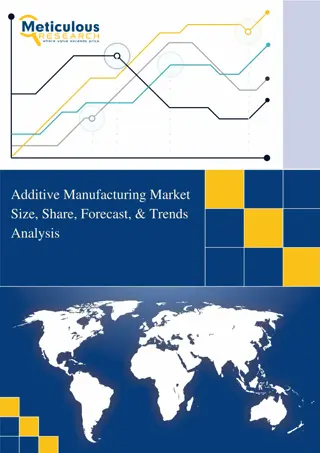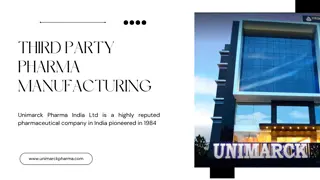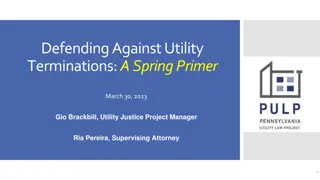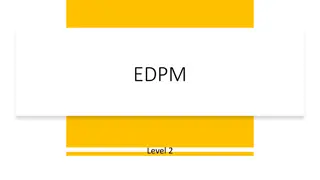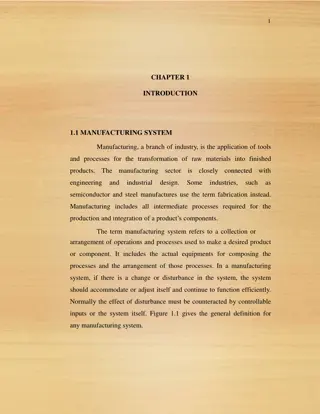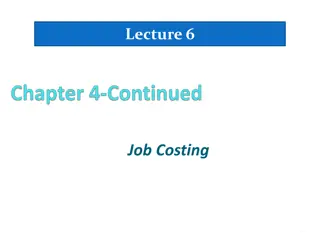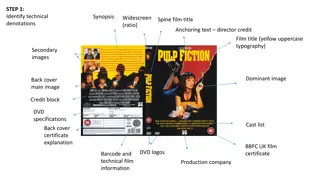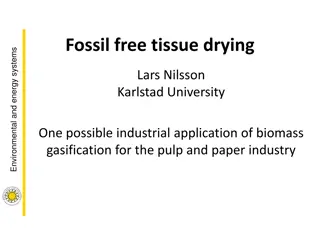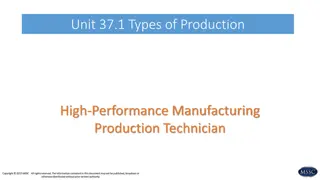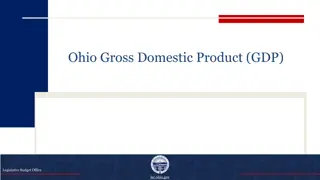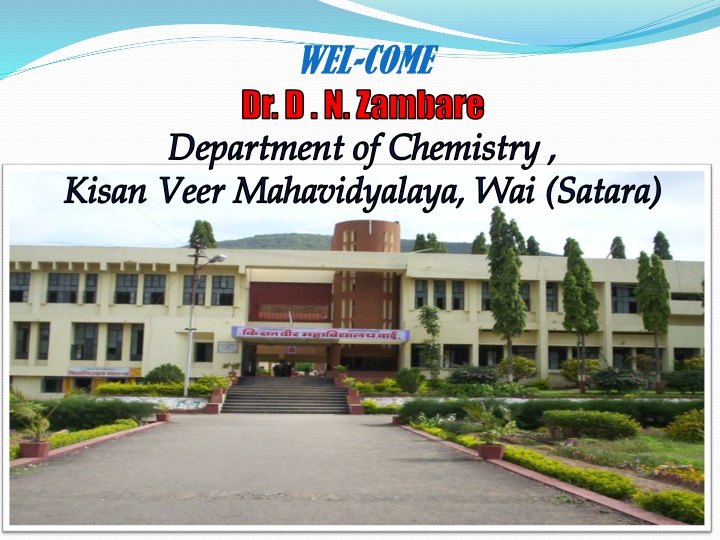
Manufacturing of Pulp and Paper Industry Overview
This content discusses the manufacturing processes of pulp in the paper industry, including mechanical and chemical methods. It delves into the steps involved in producing pulp from wood fibers and the chemistry behind soap formation. Additionally, it highlights the ecological challenges of the Indian paper industry and the features of a good paper industry.
Download Presentation

Please find below an Image/Link to download the presentation.
The content on the website is provided AS IS for your information and personal use only. It may not be sold, licensed, or shared on other websites without obtaining consent from the author. If you encounter any issues during the download, it is possible that the publisher has removed the file from their server.
You are allowed to download the files provided on this website for personal or commercial use, subject to the condition that they are used lawfully. All files are the property of their respective owners.
The content on the website is provided AS IS for your information and personal use only. It may not be sold, licensed, or shared on other websites without obtaining consent from the author.
E N D
Presentation Transcript
WEL-COME Dr. D . N. Zambare Department of Chemistry , Kisan Veer Mahavidyalaya, Wai (Satara)
4.Paper Industry Contents 4.1 Manufacturing of Pulp 4.1.1 Chemical Pulping 4.2 Types of Pulp 4.3 Manufacturing of Paper 4.4 Calendaring 4.5 Ecological Problems of Indian Paper Industry 4.6 Features of Good Paper Industry
4.1 MANUFACTURING OF PULP bagasse (waste material) etc. by mechanical and chemical means. About 80- 85% pulping is carried out by chemical process and only 8-10% by mechanical process. Pulping means disintegration of bulky fibrous material to small fibers. There are mainly two modes of production of pulp: (a) Mechanical Process: Mechanical wood pulp is obtained from pine and other soft wood such as spruce and balsam. The wood is first slashed and debarked. The debarking is usually carried out by two methods; 1. In the first method, continuous rotating cylindrical drums stationary machines fitted with agitating cam are used. In the case of drums, the wood is introduced into the upper end of a rotating drum immersed in a tank partly filled with water, where it is tumbled. The bark is rubbed off and the clean wood is discharged at the other end. 2. The debarking can also be carried out by mechanical friction or by applying high pressure water jets to individual logs by the means of hydraulic barkers in such manner that the bark is broken up and removed. Pulp is a commercial fibrous material obtained from bamboo, wood,
i) Chemistry Involved in Soap Formation: Main steps in mechanical pulping:-
presence of water in grinders to remove the heat friction and to float extremely small pieces of fibres away. The pulp and water mixture thus obtained contains all the lignocelluloses of the original wood. The mixture from grinders is withdrawn into a stick sewer, below the grinders and then conveyed to the silver screen. The fine particles of the material are collected in the screened stock pit from where these are pumped to the fine screen. The finest particles, thus screened by these screens are then concentrated in thickeners to get commercial mechanical pulp. The larger particles are retained by silver screen and the fine screens are treated in refiners and then returned to the screens again to recover more mechanical pulp. The white water overflowing from the thickeners contains about 15- 20% of the original fibers'. It is used in grinding and to aid flow in the stock sewer. The remaining fibres are strained from the white water before it is run to waste. The fibres so strained are conveyed to thickeners for concentration to mechanical pulp. As mechanical pulp can not be completely bleached, it is employed in the manufacture of cheaper grades of paper, such as required for newspaper and wrapping. Its colour can be considerably lightened by the use of bleaching agents such as sodium or calcium bisulphate, hydrogen peroxide or sodium peroxide.
(b) Chemical Process: This process is used to obtain high grade paper. Various types of pulps such as sulphate pulp, soda pulp, sulphite pulp etc. are prepared by chemical process. Chemical pulping, as its name suggests, uses chemical rather than mechanical means of separating the cellulose fibers from each other by removing the lignin, leaving behind the fiber used in paper making. Here, the wood chips are cooked in a chemical solution, which dissolves lignin and other impurities. Since chemical pulping removes lignin and other impurities, it produces a strong, bright pulp that is suited for the production of grades that require these properties, such as fine writing paper. 4.1.1 Chemical Pulping Chemical pulping involves treating wood chips with chemicals to remove the lignin and hemicelluloses, thus separating and cleaning the fibers. Delignification gives the fibers greater flexibility, resulting in a substantially stronger paper (because of greater contact between the fibers in the finished sheet) than can be manufactured from high-lignin fibers produced by mechanical pulping. Paper strength and durability is gained at the expense of fiber yield. Chemical processes may yield only half the fiber that can be recovered by the use of mechanical pulping techniques.
4.2 TYPES OF PULP Thereare various types of pulps such as: 1. Sulphate of Kraft pulp 2. Soda pulp We will discuss here sulphate and soda pulp. 1. Sulphate of Kraft Pulp: This process is most popularly used. This is an alkaline process used for any kind of hard or soft wood as the raw material. The logs are slashed, debarked and disintegrated into small chips by chippers having large rotating discs with four or more long heavy knives. The disintegrated chips are screened on rotary or vibrating screens. Then chips are passed through crushers or chippers to reduce them to proper size and digested under pressure with sodium sulphide and caustic soda for about three hours to produce more or less chemically pure fibrous cellulose. The fibrous material after separation from cooking liquor is washed with water. The water pulp is allowed to pass through knitters, riffles and screens to separate small silver or uncooked wood and finally to filters and thickeners. The thickened pulp is bleached with chlorine and washed again. It is then beaten into pulp with water in a pulp beater. During beating, long fibers are reduced to minute shreds, which absorb and hold more water. The washed pulp may be rethickened to convert it into sheets dry enough to fold into a bundle called a lap. The lapping is done on a wet thickener which consists of a cylinder immersed into vat, filled with stock solution and fitted with an end felt belt, which carries the pulp sheet through squeeze rolls and a series of press rolls. The laps thus obtained contain 35-45% air dry fiber. These laps are then stacked in hydraulic presses and subjected to pressure of about 3000 psi. The resulting laps now contain 50-60% air dry fiber. 3. Sulphite pulp
The spent cooking liquor called black liquor is removed from the pulp in the pulp washer and pumped to storage for recovery of chemicals charged to digester. It contains organic sulphur compounds, sodium sulphide, sodium carbonate and small amounts of sodium sulphate, salt, silica and traces of lime, alumina, potash and iron oxide. The black liquor is concentrated, burned, smelted and limed. As a result the carbon is burned away and inorganic compounds are melted. Moreover, sodium sulphate is converted into sodium sulphide as Na2SO4 + 2C Na2S + 2CO2 Sodium sulphide The molten smelt is then dissolved in the dissolving liquor to obtain a characteristic green liquor. It is then allowed to stand for few hours, as a result of which, insoluble impurities settle down at the bottom. Slaked lime prepared from the recovered CaCO3 is then added to the green liquor to causticize sodium carbonate till present in it. Na2CO3 + Ca(OH)2 2NaOH + CaCO3 The CaCO3 slurry is separated in settlers and rotary continuous filters, and passed to a lime kiln to get CaO for reuse in the process. The filtrate or white liquor containing caustic soda, sodium sulphide, and traces of sodium carbonate, sodium sulphate and sodium sulphide etc. is used again in the cooing of fires. Tall oil is also obtained as a byproduct from the black liquor recovery. It may be separated from the black liquor, either by means of centrifuges or by floatation from the concentrated liquors. Tall oil is used in the manufacture of soap, emulsions and greases.
Soda Pulp: caustic soda as the chemical solution and was developed in England in 1850s. The soda process gives pulp with lower tear strength than other chemical pulping process. When the Kraft process was discovered, most soda pulping mills were converted into Kraft pulping mills. The Kraft process yields a stronger pulp and is a more energy efficient process through the burning of black liquor. Today there is an increasing interest in soda pulping due to the biorefinery concept which has increased the demand for sulphur free lignin and nanocrystalline cellulose. The process structure of soda pulping mills have many similarities to the process structure of Kraft pulping mills, which makes for an interesting process alternative. Benefits of having a sulphur free process is a decrease in sulphur aerial emissions and no need for additional desulphurisation process steps. The soda pulping was performed by placing autoclaves in a temperature controlled vessel filled with polyethylene glycol. To get a concentration that could be approximated as constant bulk concentration, a solids to liquor ratio of 1 : 150 was used. When preparing the cooking liquor, 14.5 grams of sodium hydroxide was dissolved into 450 grams of deionised water. A sample of 3 grams of dry, raw or pretreated, pine wood or bark meal was then placed into the autoclave and the cooking liquor was poured in as well. Four autoclaves were placed in the heating vessel having a temperature of 80 C. The temperature was increased to 170 C at a rate of 1 C/minute and the timing for the autoclaves was started when the temperature reached 170 C. The pulping times that were examined were 30, 60, 120, 180 minutes. When the pulping was completed the autoclave was cooled in a water bath. The pulp was then filtered from the cooking liquor by using a B chner funnel with a polypropene mesh. The cooking liquor was retained for further analysis. The saved pulp was then washed with 2 litres of deionised water and placed in a convection oven at 40 C for 72 hours. The first type of chemical pulping developed was soda pulping. This process used
4.3 MANUFACTURING OF PAPER Paper is a sheet material made of fibers which are held together by hydrogen bonds. In wet process, fiber suspension in water is made and it is then made into sheet and dried. Paper making process is generally done on Fourdrinier machine. Fig. 4.3: Flow sheet for the production of paper
Functional Role of Various Units: Beater mechanically disintegrates the pulp fibers to make paper stronger, uniform, dense, opaque, etc. It consists of metal blades attached with rotating drum. Finely ground fillers (to increase brightness, flexibility, softness and weight) and coloring agents are also added. (b) Jordan: It is a conical refiner or Jordan engine. Metal bars and stones are set inside. Here, pulp is deformed, defibered and dispersed. (c) Web forming: 99.5% water fiber slurry are made to run on an endless belt at a speed of 50 m/minute to 500 m/minute. Pulp fibers are arranged into web. Water is drained out by gravity. Shaking motion is provided for better interlocking of fibers on the mat. White water is collected and it is reused to conserve water and additives and to avoid pollution. (d) Pressing: Free water is removed by pressing with pressure roll, water mark roll and suction roll. Water content is reduced to 60-65% water. (e) Drying: Additional water is removed by smoothing rolls and series of steam-heated metal drying rolls. Water is reduced from 60-65% to 5-6%. (f) Finishing: Here paper is passed through a series of calendaring rolls for producing smooth paper. It is wounded on a large winding roll. (a)Beater:
4.4 CALENDERING : smoother and receive fine glaze when they are passed through a series of hot and polished rolls, called polishing cylinders. This process is called as Calendaring. In the process, raw paper stock is converted to its end use by various means, depending upon the final form of the paper desired. The printability of paper may be improved by applying mineral or pigment surface coating. The clay is used for basic pigment coating while dyes are added for colour coatings. After calendaring and finishing, sheets of paper are ground on reels into large roll. These are then taken to slitting machine for cutting them into rolls of proper size. The manufacture of heavy paper, card board or nonuniform paper is carried out by making use of cylindrical machines. It consists of 4-7 parallel vats. Each vat is charged with similar or dissimilar paper stocks. A wire covered rotating cylinder dips into each vat. The paper stock is deposited on the turning screen as the water inside the cylinder is removed. The cylinder is so moved farther that the paper stock reaches the top, where wet layer adheres to a moving felt, which carries it to a press roll to remove some of the water. This felt and paper come in contact with the top of the next cylinder and pick up another layer of wet paper. In this manner, several layers are united together into one compact wet sheet. This is passed through press rolls and on to the steam heated drying rolls and smoothing rolls to get a dry, smooth heavy sheet. The sheet of paper obtained is rough and irregular. They became compact,
4.5 ECOLOGICAL PROBLEMS OF INDIAN PAPER INDUSTRY: Many recent pollution prevention efforts in the pulp and paper industry have focused on getting rid of use of chlorine or chlorine dioxide for bleaching, a process which helps to increase the brightness of the paper but in the process, large amounts of chlorinated pollutants such as dioxins-a persistent organic pollutant with very high cancer causing potential are released into water. The average total organochlorine (TOCL) discharge per tonne of paper produced from Indian mills has been estimated to be 2-10 kg per tonne. Furthermore, TOCL enters the food chain and does not degrade easily, the Swedish Environmental Protection Agency was unable to determine any safe level for organochlorine discharges. But in India, the pollution control boards allow a discharge of 2 kg per tonne. The state pollution control boards have not facilities to test TOCL levels and parameter has not been used for monitoring by them. In industrialized countries, most of the firms are large ones. But in India, they are mostly small or medium sized. Hence there is a little scope for investment in pollution prevention technologies. But if we ignore these mills in India, not one of the larger mills is anywhere near adopting truly environment friendly technologies or even replacing the more dangerous elemental chlorine with chlorine dioxide. Only few mills are producing chlorine dioxide in order to partially replace the use of elemental chlorine.
Fresh water consumption by Indian mills is dangerously high for health of water bodies. The mills should think in terms of harvesting rain water and recycling its effluents. For example, Sinar Mas, a mill in Maharashtra is situated in a dry region. It can meet 50% of its current needs through rain water harvesting. There is another problem, that is of disposal of solid waste. A conventional mill which has a chemical recovery system, generates about 1000-1500 kg of lime sludge, 750-1000 kg of flyash and bottom ash and around 200 kg of other waste like chipping dust per tonne of paper produced. A few mills in India have installed lime sludge recovery system, but nearly 1.5 tonnes of waste per tonne of paper produced is still being dumped by them. In comparison to some industries, pulp and paper industry seems less environmentally damaging. Water and wood fibre, are however, the most misused resources by paper and pulp industries. These units rely on raw materials, mainly wood fibres and water, which are renewable and the products they manufacture- paper and paper boards are recyclable too. But this sustainability will last only if the natural resources are properly managed. In practice, however, the paper and pulp industry is a voracious consumer of natural resources like water, wood fibres and energy and during production and disposal stages, a large proportion of these comes out in the form of waste. Thus, the pulp and paper industry, has a varied range of adverse environmental impacts throughout its life cycle. Therefore there is a wide difference between the theoretical impact and actual operational impact of the pulp and paper industry on the environment.
4.6 FEATURES OF GOOD PAPER INDUSTRY The most important features of a good pulp and paper industry are: 1. The industry is expected to have a formal environmental policy statement. It is also expected to have environment departments with senior managers looking after their day to day affairs. 2. They must have installed chemical recovery plants and other elaborate mechanisms to recover chemicals in the wastages they generate. It is also desirable to install kilns to recover lime from the sludge that is left after chemicals are recovered from pulping wastes (Black liquor). 3. The industry should make improvements in bleaching processes. They are expected to move away from highly polluting elemental chlorine bleaching. There is a trend to move towards elemental chlorine free bleaching processes among the better industries. 4. The industry is better than the average Indian company at getting the maximum out of the raw material it uses. In general, such industries reveal better process efficiency and continuously decreasing trends of fibre, water, energy and chemical use. 5. The industry restores to social/farm forestry in sourcing its raw materials and is less dependent on government owned natural forests. 6. The industry which meets the pollution norms set by respective state pollution control boards for emission, effluents and solid wastes. The industry may even have its own pollution standards. 7. The industry is expected to spend a considerable amount of money to install pollution control devices such as effluent treatment plants and equipment to control emissions. 8. The industry must have capabilities and technological knowledge of recycling and reusing as much of the wastes generated as possible. One example is the generation of energy from wood chips and sludge from effluent treatment plants.



